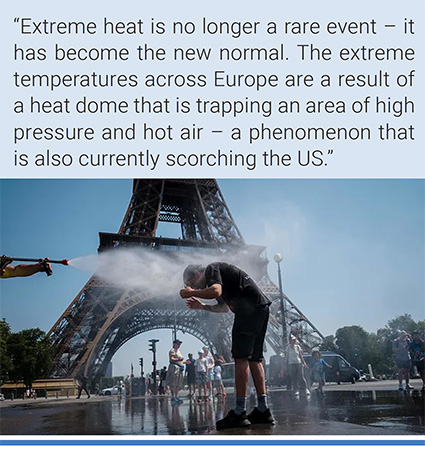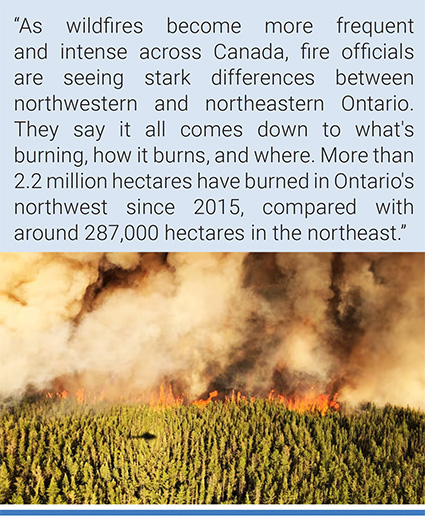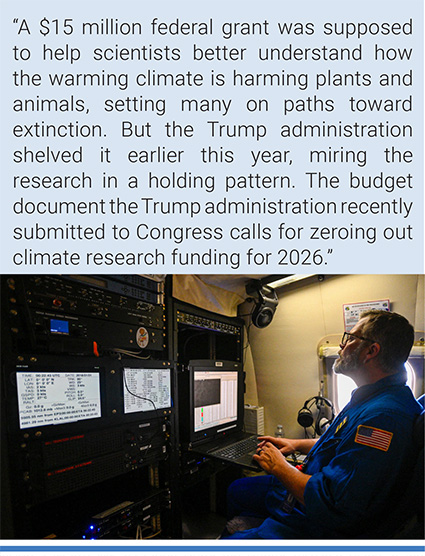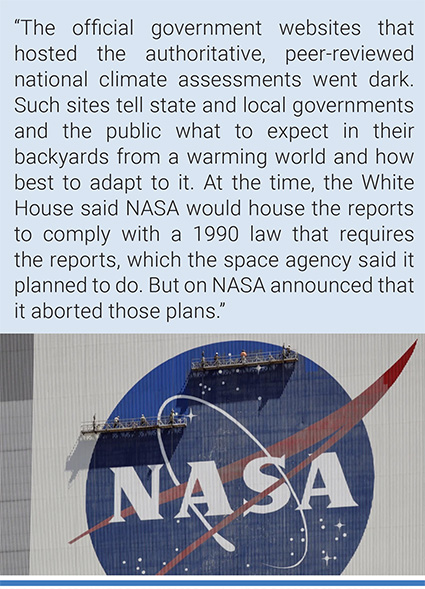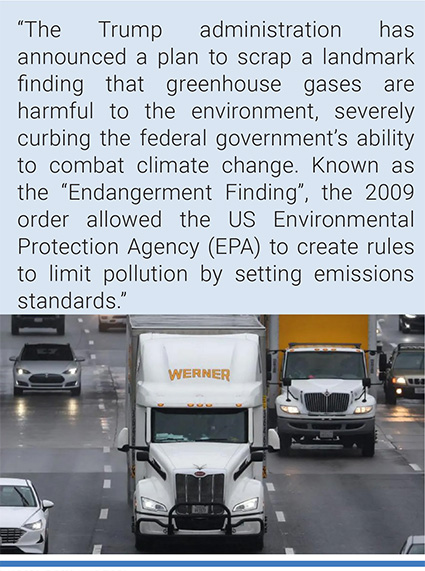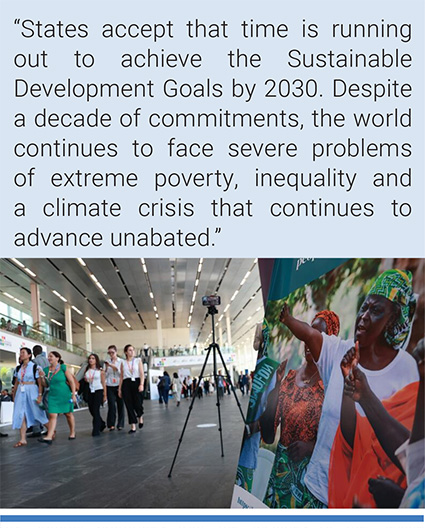Monthly Summaries
Issue 103, July 2025 | "A truly game-changing, momentous ruling"
[DOI]
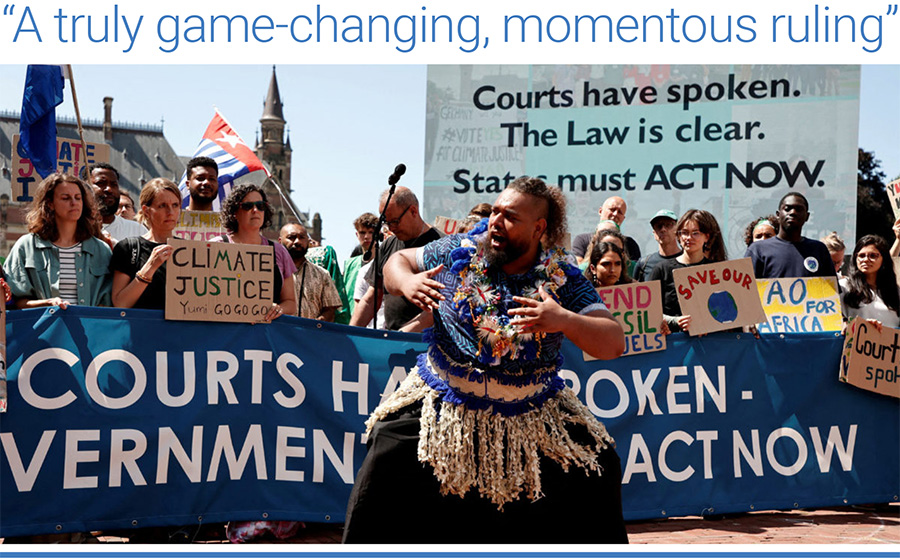
Climate activists and campaigners demonstrate outside the International Court of Justice in The Hague, Netherlands, ahead of the reading of a landmark advisory opinion that said countries harmed by the effects of climate change could be entitled to reparations. Photo: Marta Fiorin/Reuters.
June media coverage of climate change or global warming in newspapers around the globe went up 15% from June 2025. However, coverage in July 2025 was down 13% from July 2024 levels. In this larger context, Figure 1 shows that international wire services stories in July 2025 went up 16% from the previous month while remaining 24% lower than a year earlier (July 2024).

Figure 1. International wire services coverage – across The Associated Press, Agence France Presse, The Canadian Press, and United Press International (UPI) – of climate change or global warming from January 2000 through July 2025.
At the regional level, levels of July 2025 coverage went up in Africa (+1%), Latin America (+3%), Asia (+14%), the European Union (EU) (+14%), North America (+18%), and Oceania (+45%) compared to June 2025. Coverage decreased in the Middle East (-38%). Figure 2 shows trends in newspaper media coverage at the global scale – organized into seven geographical regions around the world – from January 2004 through July 2025.

Figure 2. Newspaper media coverage of climate change or global warming in print sources in seven different regions around the world, from January 2004 through July 2025.
Our Media and Climate Change Observatory (MeCCO) team continues to provide three international and seven ongoing regional assessments of trends in coverage, along with 16 country-level appraisals each month. Visit our website for open-source datasets and downloadable visuals.
A municipal employee pours water on a tourist at the Eiffel Tower. Photo: AFP. |
Moving to the content of news coverage about climate change in July 2025, there were several ongoing media stories relating to ecological and meteorological dimensions of climate change or global warming. To begin, heatwaves across Europe – with links to a changing climate – sparked news attention. For example, BBC News journalist Malu Cursino reported, “A wildfire in Spain and high temperatures elsewhere in Europe have claimed another six lives as the continent swelters in temperatures topping 40C. Two farmers died when they became trapped by flames near the town of Coscó in Spain's Catalonia region. Authorities said a farm worker had appealed to his boss for help, but they were unable to escape as fire spread over a large area. In Italy, two men died after becoming unwell on beaches on the island of Sardinia, and a man in his 80s died of heart failure, after walking into a hospital in Genoa. A 10-year-old American girl collapsed and died while visiting the Palace of Versailles south-west of Paris, reports said. According to French broadcaster TF1, she collapsed at the courtyard of the royal estate, in front of her parents, at around 18:00 local time on Tuesday. Despite efforts by the castle's security team and emergency services, she was pronounced dead an hour later. France's ecological transition minister Agnès Pannier-Runacher said earlier that two heat-related fatalities had been recorded in France and that more than 300 people had been given emergency care. The European continent is experiencing extremely high temperatures, a phenomenon that the UN's climate agency said is becoming more frequent due to "human-induced climate change". Both Spain and England had their hottest June since records began. Spain's weather service, AEMET, said last month's average temperature of 23.6C (74.5F) "pulverised records", surpassing the normal average for July and August”. Elsewhere, Guardian correspondent Ajit Niranjan reported, “vicious heatwave has engulfed southern Europe, with punishing temperatures that have reached highs of 46C (114.8F) in Spain and placed almost the entirety of mainland France under alert. Extreme heat, made stronger by fossil fuel pollution, has for several days scorched Portugal, Spain, France, Italy and Greece as southern Europe endures its first major heatwave of the summer. The high temperatures have prompted the authorities in several countries to issue new health warnings and scramble firefighters to prevent wildfires from breaking out. More than 50,000 people in Turkey have been evacuated from their homes due to forest fires, according to the interior ministry’s disaster and emergency management authority. António Guterres, the UN secretary general, said at a development conference in Seville on Monday: “Extreme heat is no longer a rare event – it has become the new normal” … The extreme temperatures across Europe are a result of a heat dome that is trapping an area of high pressure and hot air – a phenomenon that is also currently scorching the US. It comes amid an ongoing marine heatwave that has left the Mediterranean 5C hotter than normal, according to data from the University of Maine’s climate change institute. Dr Michael Byrne, a climate scientist at the University of St Andrews, said heat domes were nothing new but the temperatures they delivered were. “Europe is more than 2C warmer than in preindustrial times, so when a heat dome occurs it drives a hotter heatwave,” he said. Doctors across the continent warned people to take extra care in the hot weather, encouraging them to stay out of the heat, drink lots of water, wear loose clothing and check in on vulnerable neighbours. Researchers estimate that dangerous temperatures in Europe will kill 8,000 to 80,000 more people a year by the end of the century, as the lives lost to stronger heat outpace those saved from milder cold”. In Spain, El Mundo journalist Carlos Fresneda noted, “Heat waves in southern Europe are increasingly earlier and more intense, affecting larger geographic areas. France, with 90% of its territory on red or orange alert and temperatures 10 degrees above average at the end of June, has been the most affected country, along with Spain and Portugal, where 46.6 degrees were recorded in Mora, about 100 kilometers east of Lisbon. Italy and Greece have also suffered the impact of the heat, with temperatures hovering around 40 degrees, and in the United Kingdom (which already surpassed the mark three years ago), the hottest start in the history of the Wimbledon tournament was confirmed with 33 degrees. "Europe has experienced very high temperatures since the beginning of June, more typical of July and August, which used to occur rarely throughout the summer," says Samantha Burgess of the European Centre for Medium-Range Weather Forecasts (ECMWF).”
Ontario's northwest region is prairie-influenced says Alison Lake, a fire information officer with the Ministry of Natural Resources. Photo: Ministry of Northern Development, Mines, Natural Resources and Forestry. |
Media coverage of wildfires – with connections made to climate change – continued in July. For example, UK Telegraph journalist Niamh Robinson reported, “Wildfires raged through Greece for a second day with several popular tourist islands among the worst-hit areas. Firefighters battled five fires on Sunday across the islands of Evia, Kythira and Crete, as well as in the Peloponnese area, west of Athens, as temperatures reached highs of 40C. Giorgos Komninos, the deputy mayor of the island, told ERT News channel: “If air assets don’t come here, we will burn.” He spoke of “unimaginable destruction” and claimed there had been delays in the aerial response, with flames now threatening monasteries and tourist areas”. Elsewhere, Canadian Broadcasting Service correspondent Faith Greco reported, “As wildfires become more frequent and intense across Canada, fire officials are seeing stark differences between northwestern and northeastern Ontario. They say it all comes down to what's burning, how it burns, and where. More than 2.2 million hectares have burned in Ontario's northwest since 2015, according to the Ministry of Natural resources, compared with around 287,000 hectares in the northeast. "The three things that we need to consider when we talk about the differences here is the climate and the weather, the fuels and the topography," said Chelene Hanes, a wildland fire research scientist at the Great Lakes Forestry Centre in Sault Ste. Marie. Northwestern Ontario typically gets a minimal amount of rain, whereas the northeast has a wetter climate and vast peatlands, she explained.
Weather in the northwest region is prairie-influenced, said Alison Lake, a fire information officer with the Ontario Ministry of Natural Resources, in a statement to CBC News. It's marked by large and highly convective storm systems — severe local storms associated with thunder, heavy rain, hail, strong winds, sudden temperature changes and lightning — resulting in lightning-caused fires, Lake said”. Meanwhile, a feature article by New York Times journalists Sachi Kitajima Mulkey and Harry Stevens noted, “In 2023 and 2024 the world’s forests absorbed only a quarter of the carbon dioxide they did in the beginning of the 21st century, according to data from the World Resources Institute’s Global Forest Watch. Those back-to-back years of record-breaking wildfires hampered forests’ ability to tuck away billions of tons of carbon dioxide, curbing some of the global warming caused by emissions from burning fossil fuels. Those two years also marked the first time wildfires surpassed logging or agriculture-driven deforestation as the biggest factor lowering forests’ carbon-capturing ability. It’s an emerging pattern that’s different from the last big drop, in 2016 and 2017, which was largely the result of increased deforestation for agriculture. Carbon dioxide, a greenhouse gas, acts as a blanket in the atmosphere, trapping the sun’s heat and warming the environment. In some places, rampant burning and deforestation have tipped the scales, turning forests into a source of carbon dioxide emissions instead of a tool for capturing them”.
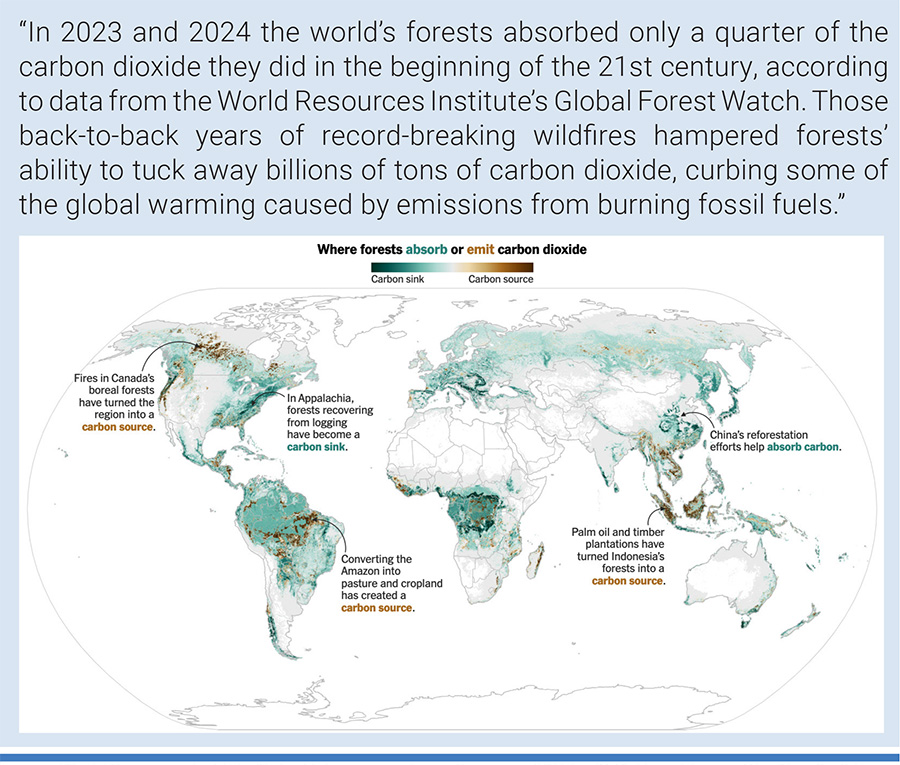
Source: World Resources Institute Note: Data averaged over the years 2001 to 2024. Harry Stevens/The New York Times.
Media portrayals in July 2025 also featured related and ongoing cultural-themed stories relating to climate change or global warming. To illustrate, in the US the ongoing ‘war on woke’ mapped onto developments in Artificial Intelligence (AI) and climate change in several ways. For example, US National Public Radio correspondent Bobby Allyn reported, “President Trump on Wednesday signed an executive order requiring artificial intelligence companies that do business with the federal government to strip AI models of "ideological agendas." Speaking at an AI summit in Washington, Trump said: "The American people do not want woke Marxist lunacy in the AI models." The order bans federal agencies from contracting with tech companies that operate AI chatbots displaying partisan bias, which the action defines as diversity, equity and inclusion, critical race theory, "transgenderism" — forces the order says pose "an existential threat to reliable AI." "From now on, the U.S. government will deal only with AI that pursues truth, fairness and strict impartiality," Trump said. The White House is also planning to revise Biden-era federal guidelines for AI safety to remove references to diversity, equity and inclusion, climate change and misinformation, according to the Trump administration's AI action plan”.
Also, ongoing tariff threats and negotiations led by US Trump Administration officials permeated culture-themed (as well as political- and economic-themed) news stories in July. For example, US National Public Radio correspondent Jaclyn Diaz reported, “At a small, industrial roastery in Washington, D.C., the nutty, inviting smell of roasting coffee hangs heavy in the air. It's where Lost Sock Roasters, a local company, roasts and packages its coffee beans — destined for its two cafes, customers' homes and local bakeries and restaurants. But something else is grabbing his attention these days: tariffs. This month, President Trump announced plans to levy a 50% tariff on all goods from Brazil — the world's largest coffee producer and the source of about 30% of U.S. coffee imports. That's on top of the 10% tariff that impacts nearly everything the U.S. brings in. This looming tariff threat has sent shock waves through the U.S. coffee industry, raising fears especially among small roasters like Lost Sock…The past several years have been volatile for the coffee industry, contributing to a major increase in market prices for coffee even in the last year, Barr says. The price volatility can be attributed, in part, to the COVID-19 pandemic and back-to-back low-yield coffee harvests in Brazil in the last year, Yerxa says. Those weak harvests, in turn, are due to drought and high temperatures and more generally climate change, which has negatively impacted coffee harvests for several years”.
Meanwhile, Pope Leo XIV's comments about climate change and the environment earned media attention in July. For example, La Vanguardia journalist Francesco Olivo wrote, “The tone is always serene, but the words are sharp. Leo XIV begins to mark his pontificate and he does so also by speaking about the environment, in an “ecological” mass in which he invoked the conversion of climate change deniers (…) In a mass celebrated last July 9 in the gardens of Castel Gandolfo, the residence where he retired for a few days of rest, the Pope focused his message on “the care of creation” and in the homily, delivered largely improvised, he launched a message of extreme clarity: the world “is burning as much from global warming as from armed conflicts”, and the “mission of Christians is to protect creation, to bring it peace and reconciliation” (…) Robert Francis Prevost also spoke of the “conversion of so many people, inside and outside the Church, who still do not recognize the urgency of caring for our common home”, marked by “so many natural disasters” that “in large part or at least in part” are caused by “excesses of the human being.”
In later July, an opinion by the International Court of Justice on human rights and climate change generated news. For example, US Public Broadcasting Service correspondent Kenichi Serino reported, “The International Court of Justice, the United Nations’ top court, issued an advisory opinion Wednesday that found all nations must tackle climate change and those that do not act could be obliged to pay reparations for the harm caused to the environment. Nikki Reisch, director of climate and energy at the Center for International Environmental Law, said she was “floored” when she heard the judgment. “This is a truly game-changing, momentous ruling that opens the door for climate justice and accountability and shuts the door on big polluters’ impunity,” she said. The ruling was the result of years of efforts by activists and small island nations. The case was first initiated by Pacific Islands Students Fighting Climate Change, a group of young Pacific Islanders facing the existential threat of rising sea levels, and led by the island nation of Vanuatu. Their lobbying resulted in the U.N. General Assembly voting in 2023 to ask the court to take up the legal question of climate change and issue an advisory opinion, a ruling that would not be binding but would provide guidance to other courts and governments”. As a second example, UK Times environment editor Adam Vaughan wrote, “Britain should not apologise for its role in the Industrial Revolution a minster has insisted, after the UN’s highest court opened the door to climate reparations. In a decision that could increase the chance of nations hit by extreme weather claiming damages from other governments, the International Court of Justice (ICJ) said that inaction on tackling climate change by a state could constitute “an internationally wrongful act”, suggesting reparations were a possibility. The court’s 140-page advisory opinion on states’ obligations on curbing global warming — and the consequences if they fail to — was the first time the ICJ had issued a stance on the subject. The view is non-binding on governments, including Britain, and the US does not recognise the court’s jurisdiction. However, the ICJ’s advisory opinions carry great legal weight and are seen to contribute to the clarification of international law”.

Figure 3. Examples of newspaper front pages with climate change stories in July 2025.
Inside a NOAA WP-3D Orion Hurricane Hunter research plane at the National Oceanic and Atmospheric Administration's Aircraft Operations Center. Photo: Miguel J. Rodriguez Carrillo/AFP/Getty Images. |
In July, many political and economic-themed media stories about climate change or global warming were evident. For instance, the US Trump Administration’s approach to budget cutting had several detrimental impacts on climate action. This generated several news stories across the country and around the world. For example, Fox News reporter Alec Schemmel noted, “Critics of President Donald Trump wasted no time blaming staffing cuts at the National Weather Service (NWS) for the widespread death and destruction caused by the floods in Texas, a reaction the White House called "shameful and disgusting." Washington Democratic Gov. Jay Inslee did not directly blame Trump's approach to climate change for the deaths, but he suggested the president's efforts to peel back green energy funding are a contributing factor to increased catastrophic natural disasters, like this weekend's flood in Texas. "It is hard to make the Texas flood tragedy worse, except to know that on the same day Trump signed a bill cratering solar and wind energy that is vital in the battle against the climate change making these torrential rains more frequent," Inslee wrote on X this weekend. During an interview with CNN, Rep. Joaquin Castro, D-Texas, added that he didn't think it was helpful to have open leadership positions that, if filled, could "help prevent these strategies." "I don’t think it’s helpful to have missing key personnel from the National Weather Service not in place to help prevent these tragedies," Castro said, adding "we have to figure out in the future how we make sure that it doesn’t happen again”. Meanwhile, Washington Post correspondent Scott Dance wrote, “A $15 million federal grant was supposed to help scientists better understand how the warming climate is harming plants and animals, setting many on paths toward extinction. But the Trump administration shelved it earlier this year, miring the research in a holding pattern… budget document the Trump administration recently submitted to Congress calls for zeroing out climate research funding for 2026, something officials had hinted at in previous proposals but is now in lawmakers’ hands. But even just the specter of President Donald Trump’s budget proposals has prompted scientists to limit research activities in advance of further cuts. Trump’s efforts to freeze climate research spending and slash the government’s scientific workforce have for months prompted warnings of rippling consequences in years ahead. For many climate scientists, the consequences are already here. With so much uncertainty across scientific agencies and academic research centers, even prominent scientists are hitting dead ends”. With an international lens, journalist Mike Phillips at The Associated Press reported, “The sprawling tax and policy bill that passed Congress repeals a multibillion-dollar green bank for financing climate-friendly projects, and the Trump administration should be allowed to freeze its funding and cancel related contracts with nonprofits, federal officials said in a court filing. Climate United Fund and other nonprofits in March sued the Environmental Protection Agency, its administrator Lee Zeldin and Citibank, which held the program’s money. The lawsuit argued the defendants had illegally denied the groups access to billions awarded last year through the Greenhouse Gas Reduction Fund, commonly referred to as a “green bank.” The program was created by the 2022 Inflation Reduction Act”.
Workers on scaffolding repaint the NASA logo near the top of the Vehicle Assembly Building at the Kennedy Space Center. Photo: John Raoux/AP. |
Further climate-related US federal program and job cuts were documented extensively by various media accounts in July. For example, Associated Press journalist Seth Borenstein wrote, “the Trump administration on Monday took another step to make it harder to find major, legally mandated scientific assessments of how climate change is endangering the nation and its people. Earlier this month, the official government websites that hosted the authoritative, peer-reviewed national climate assessments went dark. Such sites tell state and local governments and the public what to expect in their backyards from a warming world and how best to adapt to it. At the time, the White House said NASA would house the reports to comply with a 1990 law that requires the reports, which the space agency said it planned to do. But on Monday, NASA announced that it aborted those plans”. As a second example, Guardian correspondents Nina Lakhani and Gabrielle Canon noted, “Thousands of employees at the US Department of Agriculture will be forced to take salary cuts and relocate out of the Washington DC area, as part of a major restructuring that experts warn will further weaken support for American farmers and complicate wildfire response. In a memorandum issued on Thursday, the agriculture secretary, Brooke Rollins, outlined the “key pillars” behind the department’s reorganization, focused on reducing its financial footprint, removing resources from the capital, eliminating management and consolidating workforces responsible for a range of functions, including freedom of information requests, tribal relations, grants and human resources. More than half of employees working in the Washington DC area will be relocated to five locations – Raleigh, North Carolina; Kansas City, Missouri; Indianapolis, Indiana; Fort Collins, Colorado; and Salt Lake City, Utah. Several key USDA offices will be shuttered in the capital region. The move follows wide-ranging and often chaotic cuts to staff and services being implemented under Trump 2.0, as the administration seeks to dismantle the federal government and fund tax cuts for the wealthy including the president’s billionaire donors… experts warned that the latest cuts and consolidation of key departments focused on civil rights and small and disadvantaged businesses will further hamstring the agency, which is already reeling. The latest upheaval follows widespread cuts to Biden era agricultural programs, research grants and staff across the country, which along with Trump’s tariff chaos and deepening climate chaos has caused panic among many farmers”.
Photo: Getty Images. |
At the end of the month, US Trump Administration moves through the Environmental Protection Agency to potentially stop regulating carbon emissions earned media coverage in the US and around the world. For example, New York Times reporters Maxine Joselow and Lisa Friedman wrote, “Lee Zeldin, the administrator of the Environmental Protection Agency, said on Tuesday the Trump administration would revoke the scientific determination that underpins the government’s legal authority to combat climate change. Speaking at a truck dealership in Indianapolis, Mr. Zeldin said the E.P.A. planned to rescind the 2009 declaration, known as the endangerment finding, which concluded that planet-warming greenhouse gases pose a threat to public health. The Obama and Biden administrations used that determination to set strict limits on greenhouse gas emissions from cars, power plants and other industrial sources of pollution. “The proposal would, if finalized, amount to the largest deregulatory action in the history of the United States,” Mr. Zeldin said. He said the proposal would also erase limits on greenhouse gas emissions from cars and trucks on the nation’s roads. Without the endangerment finding, the E.P.A. would be left with no authority under the Clean Air Act to regulate the greenhouse gas emissions that are accumulating in the atmosphere from the burning of fossil fuels. The proposal is President Trump’s most consequential step yet to derail federal climate efforts. It marks a notable shift in the administration’s position from one that had downplayed the threat of global warming to one that essentially flatly denies the overwhelming scientific evidence of climate change. It would not only reverse current regulations, but, if the move is upheld in court, it could make it significantly harder for future administrations to rein in climate pollution from the burning of coal, oil and gas. Without the United States working to reduce emissions, it becomes far tougher for the world to collectively prevent average global temperatures from rising by more than 1.5 degrees Celsius, or 2.7 degrees Fahrenheit, above preindustrial levels. That is the threshold beyond which climate scientists say there is significantly greater risk from increasingly destructive storms, droughts, wildfires and heat waves, as well as from species extinction”. As a second example, BBC News journalist Bernd Debusmann Jr reported, “The Trump administration has announced a plan to scrap a landmark finding that greenhouse gases are harmful to the environment, severely curbing the federal government's ability to combat climate change. Known as the "Endangerment Finding", the 2009 order from then-President Barack Obama allowed the US Environmental Protection Agency (EPA) to create rules to limit pollution by setting emissions standards. The US is a major contributor to global climate change, and ranks second only to China which emits more planet-warming gases like carbon dioxide – and the US still emits more per person. Experts have warned that the move could have a devastating impact on the environment. President Donald Trump has long argued that climate regulations stifle US economic growth, and on his first day back in office in January ordered that the EPA submit recommendations "on the legality and continuing applicability" of the Endangerment Finding. The Endangerment Finding stemmed from a 2007 Supreme Court case in which the court ruled that greenhouse gases are "air pollutants" - meaning that the EPA has the authority and responsibility to regulate them under the US Clean Air Act. In 2009, the EPA made an official decision, the Endangerment Finding, which found that greenhouse gas emissions from sources such as cars, power plants and factories cause climate change and could pose a public health risk. The decision forms the core of the federal government's authority to impose limits on carbon dioxide, methane and other greenhouse gases. In a statement, the EPA said that, if finalised, the move will save Americans $54bn (£40bn) in costs annually through the repeal of greenhouse gas standards, including an electric vehicle mandate passed by the Biden administration”.
UN Summit attendees tour the facilities of the Seville Conference Center. Photo: Rocío Ruz/Europa Press. |
The aforementioned meeting in Sevilla generated several political and economic themed stories relating to climate change too. For example, El País explained, “States accept that time is running out to achieve the Sustainable Development Goals by 2030. Despite a decade of commitments, the world continues to face severe problems of extreme poverty, inequality and a climate crisis that continues to advance unabated…Although the Commitment, despite its name, is not a binding text nor has the status of an international treaty, it at least provides countries with a minimum framework to work within in the coming years, which will undoubtedly be marked by Donald Trump's transactional vision of international relations…The Seville summit highlights both the enormous financing problem facing cooperation and the need to reform the so-called international financial architecture, to prevent the debt of some countries from continuing to perpetuate their poverty.”
Last, several July 2025 media stories featured several scientific themes in news accounts. In early July, reports linking the devastating flooding in the US state of Texas with climate change made news. For example, CNN journalist Andrew Freedman reported, “Once synonymous with leisure and reprieve, summer has increasingly become a season marked by anxiety and disruption. Fossil fuel pollution — alongside other compounding factors — has transformed these months into a time of mounting peril, punctuated by relentless heat waves, rampant wildfires and catastrophic flooding. This summer, in particular, has been defined by a tragic surge in deadly flash floods across the United States, underscoring the escalating volatility of our warming world. It’s no accident this is the summer of flooding, climate scientists say, with 100-year to 1,000-year deluges happening nearly simultaneously in multiple states on multiple days. Large parts of the US have seen an unusually humid summer with record amounts of moisture in the air. When cold fronts and other weather systems come along, that moisture can get wrung out, squeezed like a water-laden sponge, yielding heavy and often highly localized downpours. For much of the summer, the atmospheric conditions over the US have funneled humid air north from the unusually warm Gulf and western Atlantic, including the Gulf Stream, UCLA climate researcher Daniel Swain told CNN. This has yielded unusually high levels of moisture at all levels of the atmosphere across the US east of the Rockies, Swain said. It has led to record levels of what meteorologists call precipitable water, which is the amount of rain that would result from instantaneously extracting all the water in the air”. Meanwhile, turning back to political elements Fox News reporter Lindsay Kornick noted, “Rep. Jasmine Crockett, D-Texas, accused Republicans on Friday of wanting to "bury their constituents" after the deadly Texas floods by rolling back ways to combat climate change… More than 120 people were killed in the flash flooding with dozens reported missing. Since last week, several Democratic figures have been quick to politicize the floods by blaming climate change and President Donald Trump’s government cuts to the National Weather Service (NWS) for exacerbating the damage”. Bridging to ecological- and meteorological-themed stories (see above), New York Times journalist David Gelles wrote, “The floods that ravaged Texas last week, leaving more than 105 people dead, occurred in a region known as Flash Flood Alley. And while the storm developed quickly, the National Weather Service offered what appears to have been a relatively good forecast in a rapidly developing situation, according to former Weather Service officials. But despite known risks in the area and warnings that were first issued around midnight Thursday, the floods became one of the deadliest weather events in recent American history. How did that happen? It’s too early to say with certainty that the slow-moving thunderstorms were made worse by man-made climate change. But the weather pattern that unleashed more than 10 inches of rain in a matter of hours is precisely the kind of phenomenon that scientists say is becoming more common because of global warming”.

Figure 4. Examples of newspaper front pages covering the Texas flooding with connections to climate change in early July 2025.
Meanwhile, new research shared in July linked glacial melt and volcanic eruptions: this earned media attention. For example, Guardian environment editor Damien Carrington wrote, “The melting of glaciers and ice caps by the climate crisis could unleash a barrage of explosive volcanic eruptions, a study suggests. The loss of ice releases the pressure on underground magma chambers and makes eruptions more likely. This process has been seen in Iceland, an unusual island that sits on a mid-ocean tectonic plate boundary. But the research in Chile is one of the first studies to show a surge in volcanism on a continent in the past, after the last ice age ended. Global heating caused by the burning of fossil fuels is now melting ice caps and glaciers across the world. The biggest risk of a resurgence of volcanic eruptions is in west Antarctica, the researchers said, where at least 100 volcanoes lie under the thick ice. This ice is very likely to be lost in the coming decades and centuries as the world warms. Volcanic eruptions can cool the planet temporarily by shooting sunlight-reflecting particles into the atmosphere. However, sustained eruptions would pump significant greenhouse gases into the atmosphere, including carbon dioxide and methane. This would further heat the planet and potentially create a vicious circle, in which rising temperatures melt ice that leads to further eruptions and more global heating”.
- report prepared by Max Boykoff, Rogelio Fernández-Reyes, Ami Nacu-Schmidt, Jeremiah Osborne-Gowey and Olivia Pearman

